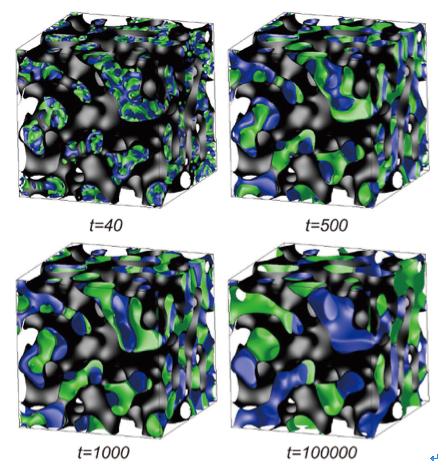Shape separates substance

Two demixed phases [the green and blue phases] are shown together with the porous structure surface (black). Credit: Hajime Tanaka and Ryotaro Shimizu, Tanaka Laboratory, Institute of Industrial Science, The University of Tokyo
Researchers at University of Tokyo Institute of Industrial Science (IIS) report a new physical model that shows how the topology of a porous material influences the phase separation of binary mixtures. The model uses two variables, the density field of a porous structure and the composition field of a binary mixture, to show that topology has very different effects on phase separation depending on the porous structure being random and either 2D or 3D. The study can be read in Science Advances.
As IIS Professor Hajime Tanaka, who led the study, explains, the phase separation of binary mixtures, or demixing, in porous materials depends on two factors.
“Phase separation, surface wettability and the geometrical structure of the pore are all interconnected. Structure depends on size and topology. It is very difficult to study topology.”
Understanding this influence has applications in widely different fields including battery, medical diagnostics and oil extraction.
Previous studies have generally assumed that pores can be approximated to be an assembly of straight cylinders, but in reality the shapes are random and can take different topologies, complicating the kinetics of the separation. To understand these effects, Tanaka and his collaborator, Dr. Ryotaro Shimizu, developed a novel phase-field model to observe how two mixed substances separate when immersed into a porous material at different levels of surface wettability and two different topologies, 2D or 3D. The model showed a clear relationship between demixing and wetness, but one that was greatly influenced by the topology.
“Only 3D porous structures can be bicontinuous,” said Shimizu.
The significance of this distinction leads to unique conformations in 3D structures that Shimizu calls “double-network structures”. The result is different kinetics in the phase separation due to different topologies in the pore structure.
“Our study shows that the difference in the pore geometry causes drastic differences in the phase separation,” said Tanaka.
###
Research contact:
Professor Hajime Tanaka
Institute of Industrial Science, The University of Tokyo
4-6-1 Komaba, Meguro-ku, Tokyo 153-8505, Japan
Tel: +81 3 5452-6125
Fax: +81 3 5452-6126
Email: tanaka@iis.u-tokyo.ac.jp
About Institute of Industrial Science (IIS), the University of Tokyo:
Institute of Industrial Science (IIS), the University of Tokyo is one of the largest university-attached research institutes in Japan. More than 120 research laboratories, each headed by a faculty member, comprise IIS, with more than 1,000 members including approximately 300 staff and 700 students actively engaged in education and research. Our activities cover almost all the areas of engineering disciplines. Since its foundation in 1949, IIS has worked to bridge the huge gaps that exist between academic disciplines and real-world applications.
Media Contact
All latest news from the category: Materials Sciences
Materials management deals with the research, development, manufacturing and processing of raw and industrial materials. Key aspects here are biological and medical issues, which play an increasingly important role in this field.
innovations-report offers in-depth articles related to the development and application of materials and the structure and properties of new materials.
Newest articles

First-of-its-kind study uses remote sensing to monitor plastic debris in rivers and lakes
Remote sensing creates a cost-effective solution to monitoring plastic pollution. A first-of-its-kind study from researchers at the University of Minnesota Twin Cities shows how remote sensing can help monitor and…

Laser-based artificial neuron mimics nerve cell functions at lightning speed
With a processing speed a billion times faster than nature, chip-based laser neuron could help advance AI tasks such as pattern recognition and sequence prediction. Researchers have developed a laser-based…

Optimising the processing of plastic waste
Just one look in the yellow bin reveals a colourful jumble of different types of plastic. However, the purer and more uniform plastic waste is, the easier it is to…



